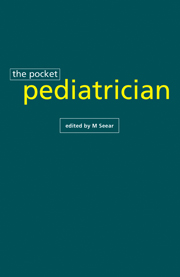Book contents
- Frontmatter
- Contents
- Analytical contents list
- Preface
- 1 Cardiology
- 2 Death and dying
- 3 Emergencies
- 4 Endocrinology
- 5 Fluids and electrolytes
- 6 Gastroenterology
- 7 General surgery
- 8 Health care ethics
- 9 Hematology
- 10 Infectious diseases
- 11 Intensive care and continuous infusion drugs
- 12 Medical genetics
- 13 Neonatology and neonatal drug dosage guidelines
- 14 Neurology
- 15 Nutrition
- 16 Oncology
- 17 Pediatric transport
- 18 Pharmacology and drug dosage guidelines
- 19 Renal
- 20 Resident fellow training
- 21 Respirology
- 22 Rheumatology
- 23 Transfusion medicine
- 24 Appendix
- Index
21 - Respirology
Published online by Cambridge University Press: 01 February 2010
- Frontmatter
- Contents
- Analytical contents list
- Preface
- 1 Cardiology
- 2 Death and dying
- 3 Emergencies
- 4 Endocrinology
- 5 Fluids and electrolytes
- 6 Gastroenterology
- 7 General surgery
- 8 Health care ethics
- 9 Hematology
- 10 Infectious diseases
- 11 Intensive care and continuous infusion drugs
- 12 Medical genetics
- 13 Neonatology and neonatal drug dosage guidelines
- 14 Neurology
- 15 Nutrition
- 16 Oncology
- 17 Pediatric transport
- 18 Pharmacology and drug dosage guidelines
- 19 Renal
- 20 Resident fellow training
- 21 Respirology
- 22 Rheumatology
- 23 Transfusion medicine
- 24 Appendix
- Index
Summary
INTRODUCTION
A good working knowledge of respiratory medicine is essential for anyone practicing hospital pediatrics. The top three causes of acute admission to any Children's Hospital in North America are all respiratory diseases (bronchiolitis, asthma and pneumonia), while one of the commonest causes for chronic admission is cystic fibrosis. In addition, many patients admitted under other disciplines, such as Oncology, Intensive Care and Special Care Nursery, will frequently have major respiratory complications.
Respiratory medicine is not an esoteric subject. The lung has very few ways of expressing its displeasure, so most complaints will be a permutation of cough, wheeze or shortness of breath. With judicial use of common sense and a knowledge of basic physiology, most respiratory problems can be diagnosed and managed effectively.
ASSESSMENT OF LUNG FUNCTION
Respirologists are fortunate in having a large number of tests at their disposal for the evaluation of a child with a respiratory disease. These can range from peak flow readings to lung MRI. If common sense is abandoned, it is easy to waste a lot of money. Apart from a detailed history and physical examination, a standard workup should include a chest X–ray plus pulmonary function tests in children old enough to cooperate (usually an intelligent 5 year old in a good mood).
Spirometry
The use of acronyms and technical jargon makes pulmonary function testing seem a good deal more complex than it really is. Spirometry is simply a means of measuring static lung volumes, as displayed in Figure I. The volume between total lung capacity and residual volume is called vital capacity and can be measured reproducibly and accurately.
- Type
- Chapter
- Information
- The Pocket PediatricianThe BC Children's Hospital Manual, pp. 535 - 549Publisher: Cambridge University PressPrint publication year: 1996

